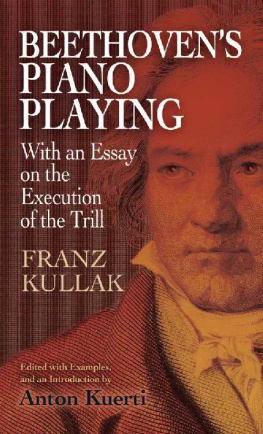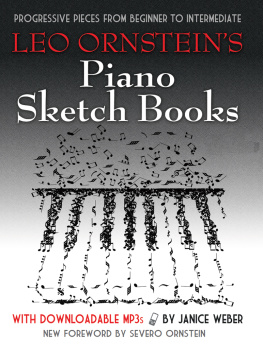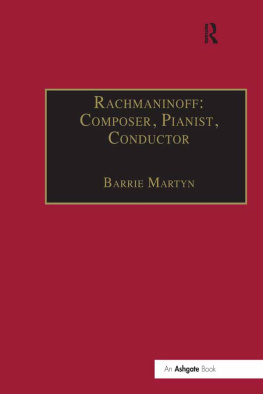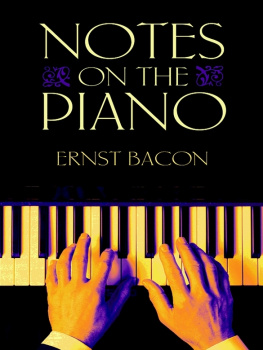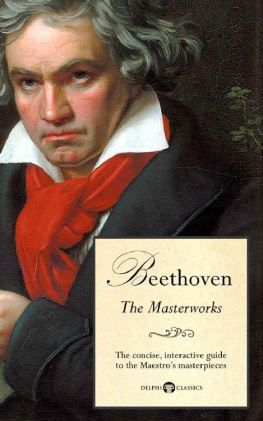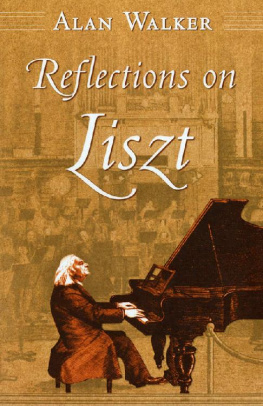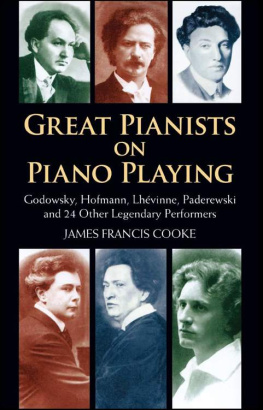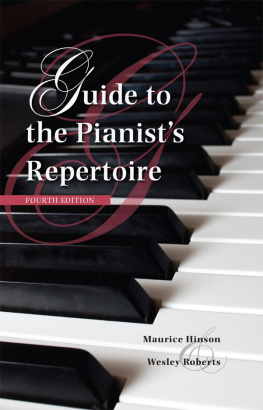BEETHOVENS PIANO PLAYING
With an Essay on the Execution of the Trill
FRANZ KULLAK
Edited with New Examples, and an Introduction by
ANTON KUERTI
Dover Publications, Inc.
Mineola, New York
Copyright
Introduction copyright 2013 by Anton Kuerti
All rights reserved.
Bibliographical Note
This Dover edition, first published in 2013, is an unabridged republication of the work originally published by G. Schirmer, New York, in 1901. Anton Kuerti has prepared a new Introduction and musical examples specially for this Dover edition.
Library of Congress Cataloging-in-Publication Data
Kullak, Franz, 18441913, author.
Beethovens piano playing: with an essay on the execution of the trill / Franz Kullak; edited with new examples and an introduction by Anton Kuerti.
p. cm.
eISBN 13: 978-0-486-31654-3
1. Beethoven, Ludwig van, 17701827. 2. PianoInstruction and study. I. Kuerti, Anton, editor. II. Title.
MT220.K99 2013
786.2092dc23
2013012733
Manufactured in the United States by Courier Corporation
499685012013
www.doverpublications.com
Contents
INTRODUCTION TO THE DOVER EDITION
Franz Kullak (18441913) is a shining example of a conscientious nineteenth-century music editor of great integrity. His editions of Beethovens Piano Concerti were published in 1901 by G. Schirmer in New York. While the omnipresent yellow Schirmer editions are generally not admired by serious musicians, Kullaks are superb. Even the new complete Beethoven edition, created by scholars of the Beethoven-Haus in Bonn and published by G. Henle in Munich, displays only the most minuscule deviations from the Kullak version, and in certain respects is actually less satisfactory (for lack of footnotes explaining some of their choices).
Kullak was determined to reproduce Beethovens music exactly as the composer wrote it, nothing added nor subtracted (except for copious footnotes where Beethovens intentions were in doubt). This approach was almost unheard of in the nineteenth century, which was replete with unscrupulous editors who arrogated to themselves the right to improve the works of the great masters by changing details of phrasing, dynamics, tempo, expression marks, and yes, even the notes themselves. This attitude can only be characterized as artistic vandalism.
Among the many who tampered irresponsibly with Beethovens piano works were the well-known musicians Eugen dAlbert, Harold Bauer, Hans von Blow, Alfredo Casella, Harold Craxton, Leopold Godowsky, Frederic Lamond, Sigmund Lebert, Max Pauer, Hugo Riemann, Artur Schnabel, and Leo Weiner.
It is fitting that Dover Publications should reprint Franz Kullaks essay on Beethovens piano playing, which originally appeared as an introduction to his edition of the Beethoven Piano Concerti. Kullak researched the information in this essay just as assiduously as he did the sources of his scores. It embraces accounts from a broad range of individuals, including ear-witnesses like Beethovens students Carl Czerny and Ferdinand Ries, his fellow composers Luigi Cherubini and Johann Cramer, his first biographer Anton Schindler, and two biographers of a later generation who were avid collectors of Beethoveniana, Gustav Nottebohm and Alexander Wheelock Thayer.
A memorable portrait emerges of Beethoven as an extremely energetic and profound performer, with a certain affinity for legato and vivid characterization, but often inaccurate and inconsistent. However, this image does not resolve without considerable contradictions, particularly in the realm of liberties and tempo modifications. Many, including Czerny, stressed that Beethoven played quite strictly in time.
Anton Schindler, on the other hand, wrote several play by play descriptions of Beethovens performances that indicate he was at times prepared to change tempi almost from bar to bar. Here is his description of the masters performance of the first movement of the Sonata in E Major Op. 14, No. 1:
In the 8th bar of the first movement Allegro he retarded the tempo, and extended the 4th right hand note. Thus he conveyed an indescribable earnestness and dignity. In the 10th bar he resumed the original tempo, but the following bars were played diminuendo and a little held back. At the second subject, the tempo became Andante, but irregular, giving the first note of the descending theme a little fermata. In the next phrase he returned to the original tempo, but in the development he broadened the rhythm... where the second movement arrives at a long chord he made a very lengthy fermata... in every movement [referring to a whole group of sonatas] Beethoven varied the tempo as the mood changed.
The degree of tempo modifications in this report may be exaggerated, especially as Schindler is known to have been unscrupulous at times (for example, he added content to Beethovens conversation books after the composers death). Still, it is my opinion that his descriptions absolutely conform to the spirit of the music, and ring true.
A possible explanation for the widely diverging opinions on the degree of liberty Beethoven allowed himself is that some performers of the day permitted themselves such outrageous excesses that by comparison it seemed Beethoven played very strictly. Czerny, though testifying to Beethovens steadiness of tempo, on the other hand gave detailed interpretative instructions in his Complete Theoretical and Practical Piano Forte School Op. 500, to the effect of play a little faster here, slow down there, hold this chord a bit longer, etc.
The imaginative performer will not attempt to align his or her inspiration to the cruel, unyielding tick of a metronome. Every piece of music, indeed every movement, is a unique creation. According to their individual character, some, like the finale of Beethovens Sonata Op. 31, No. 2 (the Tempest), require an absolute steadiness of tempo; others, like the Sonata Op. 14, No. 1 described above, or the improvisatory second subject of Op. 109, need daring doses of flexibility to fully bring out their extraordinary flavor. The divergent testimony of those close to Beethoven may also be related to exactly which works they heard him play.
The great performer will allow each note to find its most exquisite personal length, without imposing a calculated distortion on the composition. As in every detail of interpretation, the line dividing great artistry from mannered exhibitionism is elusive, hard to find, and easy to violate; while a timid approach to these matters may facilitate a decent performance, it will never result in a towering one. Better to risk offending the listener than to take refuge in unassailable competence.
Kullak devotes quite a few pages to a discussion of metronome marks; he quotes Beethoven as saying: No metronome at all! Whoever has the right feeling, needs none; and whoever lacks it, has no use for one... On another occasion, Beethoven wrote a metronome mark on a manuscript, followed by this applies only to the first bar, for feeling has its own tempo, which cannot be expressed by a number, thus giving more credibility to Schindlers description of Beethovens tempo changes.
Another interesting remark, written in 1824 by Schindler in one of Beethovens conversation books, is: [we] were surprised that you deviated so markedly from the accelerated tempi of former years, and that now you consider everything to be too fast. Master, may your young son say what he feels about this? I would have liked to embrace you at the rehearsal yesterday, when you gave us all the reasons why you now feel your works differently than 15 to 20 years ago. I confess that I was not in agreement with various tempi during that period...it was clearly noticeable, and observed by many, that you now wanted all the allegros slower... what a remarkable difference! How much emerged from the inner voices that was previously impossible to hear and often muddled
Next page
